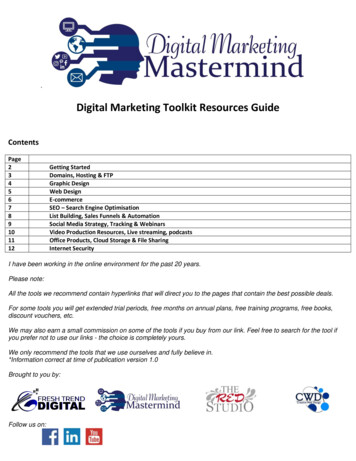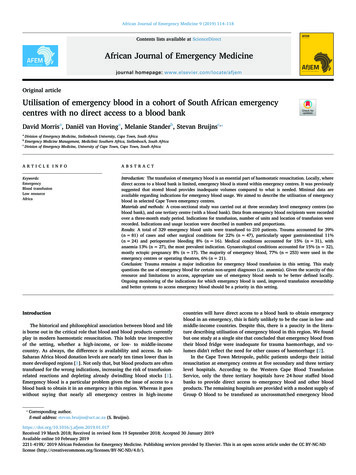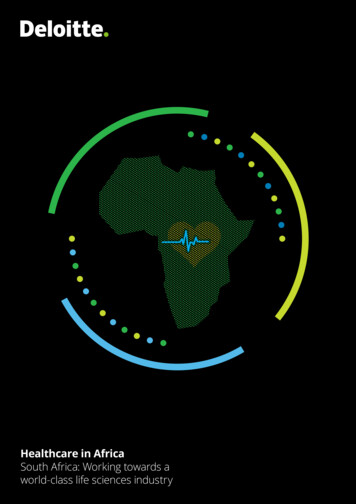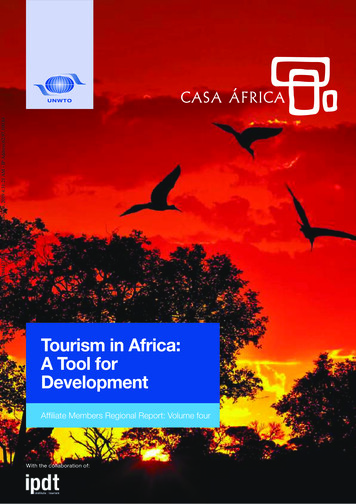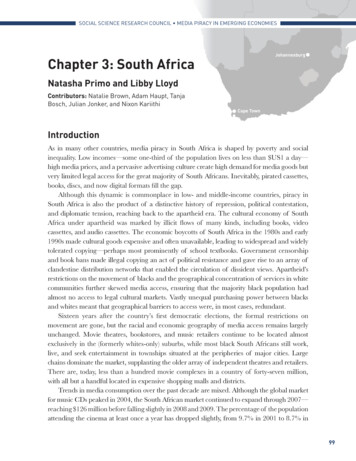
Transcription
SOCIAL SCIENCE RESEARCH COUNCIL MEDIA PIRACY IN EMERGING ECONOMIESJohannesburgChapter 3: South AfricaNatasha Primo and Libby LloydContributors: Natalie Brown, Adam Haupt, TanjaBosch, Julian Jonker, and Nixon KariithiCape TownIntroductionAs in many other countries, media piracy in South Africa is shaped by poverty and socialinequality. Low incomes—some one-third of the population lives on less than US1 a day—high media prices, and a pervasive advertising culture create high demand for media goods butvery limited legal access for the great majority of South Africans. Inevitably, pirated cassettes,books, discs, and now digital formats fill the gap.Although this dynamic is commonplace in low- and middle-income countries, piracy inSouth Africa is also the product of a distinctive history of repression, political contestation,and diplomatic tension, reaching back to the apartheid era. The cultural economy of SouthAfrica under apartheid was marked by illicit flows of many kinds, including books, videocassettes, and audio cassettes. The economic boycotts of South Africa in the 1980s and early1990s made cultural goods expensive and often unavailable, leading to widespread and widelytolerated copying—perhaps most prominently of school textbooks. Government censorshipand book bans made illegal copying an act of political resistance and gave rise to an array ofclandestine distribution networks that enabled the circulation of dissident views. Apartheid’srestrictions on the movement of blacks and the geographical concentration of services in whitecommunities further skewed media access, ensuring that the majority black population hadalmost no access to legal cultural markets. Vastly unequal purchasing power between blacksand whites meant that geographical barriers to access were, in most cases, redundant.Sixteen years after the country’s first democratic elections, the formal restrictions onmovement are gone, but the racial and economic geography of media access remains largelyunchanged. Movie theatres, bookstores, and music retailers continue to be located almostexclusively in the (formerly whites-only) suburbs, while most black South Africans still work,live, and seek entertainment in townships situated at the peripheries of major cities. Largechains dominate the market, supplanting the older array of independent theatres and retailers.There are, today, less than a hundred movie complexes in a country of forty-seven million,with all but a handful located in expensive shopping malls and districts.Trends in media consumption over the past decade are mixed. Although the global marketfor music CDs peaked in 2004, the South African market continued to expand through 2007—reaching 126 million before falling slightly in 2008 and 2009. The percentage of the populationattending the cinema at least once a year has dropped slightly, from 9.7% in 2001 to 8.7% in99
SOCIAL SCIENCE RESEARCH COUNCIL MEDIA PIRACY IN EMERGING ECONOMIESChapter Contents99101The Medicines Dispute and ItsShadow103Enforcement Autopilot105Sectoral s114Piracy and South African Film117Piracy on the Internet120Attitudes toward Piracy120Piracy Stories122Software Piracy in MusicProduction124Law and Enforcement125TRIPS Compliance andEnforcement Legislation126Anti-piracy under theCounterfeit Goods Act and theCopyright Act127Judicial Pushback129Public-Private Justice131132How Piracy Works in South AfricaOptical Disc Piracy133Flea Markets and StreetVendors134Market Differentiators135Bruma136Noord/Plein137Cultural Nationalism137The Deformalization of theTrade138100IntroductionHanover Park138Neighborhood Vending139Consumption140What People Watch141Conclusion144About the Study144References2008—led by a sharp decline in attendance by whites(SAARF 2008).1 This drop is usually attributed to risingticket prices, which average 35 rand ( 5) despite abrief price war from 2005 to 2007, and to the growthin the use of DVD players, which surged from 3% oftotal households in 2003 to 48.8% by the end of 2008(Euromonitor International 2009). Much of the resultingdemand for DVDs is served by pirate suppliers—up to80% according to the industry group South AfricanFederation Against Copyright Theft (SAFACT). Of theremaining legal market, rentals make up nearly 50%of revenues, leaving a very small home-video retailmarket.The end of apartheid and economic sanctions inthe mid-1990s produced a rapid flow of cultural goodsinto the South African marketplace, including movies,books, audio and video cassettes, and music CDs.The high prices and underdeveloped retail sector forthese goods, however, meant that existing grey- andblack-market practices for acquiring, copying, andcirculating media retained their place in South Africanlife—especially in poor communities. Textbook piracyremained ubiquitous and, according to the InternationalIntellectual Property Alliance (IIPA), was responsiblefor larger total losses than either film or music piracythroughout the 1990s and early 2000s. As a global tradein pirated cassettes and discs emerged in the 1990s,South Africa became both a destination market anda transit point for CD and, later, DVD smuggling intoother African countries. Industry accounts attributemuch of this traffic to disc production in SoutheastAsia—especially Malaysia—but South Asian networksalso played a role as Pakistani immigrants began to caterto, and cultivate, South African tastes for Bollywoodfilms and music.1Among the major racial groups, only blacks showed anincrease in attendance, from 4.2% to 5.2% (OMD SouthAfrica 2009, 2002). This trend may be changing, withthe major chains reporting increased attendance figuresfor 2009, driven by Hollywood blockbusters like Avatarand Iron Man.
CHAPTER THREE SOUTH AFRICADespite the large informal economy, claims of lossesto piracy in South Africa were never very high. TheIIPA—calculating only losses to US companies—putthe figure at 129 million in 2000, of which two-thirdswas attributed to business software. Brazil, Mexico, andRussia, by comparison, regularly approached 1 billionin the late 1990s in the same reports, representing twoto four times the per capita loss. Nonetheless, SouthAfrica loomed very large in wider debates about theintellectual property (IP) obligations of middle-incomeand low-income countries under the Agreementon Trade-Related Aspects of Intellectual PropertyRights (TRIPS), which sets minimum standardsfor IP protection for members of the World TradeOrganization (WTO).2The Medicines Dispute and Its ShadowIn the late 1990s, South Africa faced a massive HIV/AIDS crisis, with infection rates approaching 20% of theadult population. New antiretroviral drug “cocktails”had proven effective in controlling the disease but wereinaccessible to the vast majority of South Africans: thestandard treatments cost, on average, 12,000 per patientper year. In 1997, President Nelson Mandela signedthe South African Medicines and Medical DevicesRegulatory Act, which legalized compulsory licensingfor HIV/AIDS drugs and—more importantly—theparallel importation of drugs from lower-priced sources,notably India. Although many observers viewed the actas compliant with relatively vague TRIPS provisions2South Africa faced the challenges of compliance earlierthan many other comparable countries because it agreedto comply with TRIPS as a developed country—a statusbased on its leadership of the Southern African CustomsUnion (SACU), which the WTO classified as a developed-country region. As a result, South Africa began toimplement TRIPS in 1995. India, in contrast, negotiated a ten-year TRIPS implementation schedule thatgave them until 2005 to comply. Signatories identified bythe UN as Least Developed Countries (LDCs), such asLesotho, also a member of the SACU, have until 2016.Acronyms andAbbreviationsBACSABusiness Against Crime SouthAfricaBSABusiness Software AllianceCGACounterfeit Goods ActDTIECT ActDepartment of Trade and IndustryElectronic Communications andTransactions ActESAEntertainment SoftwareAssociationFIFAFédération Internationale deFootball Association (InternationalFederation of Association Football)IFPIInternational Federation of thePhonographic IndustryIIPAInternational Intellectual PropertyAllianceIPISPintellectual propertyInternet service providerISPAInternet Service Providers’AssociationP2Ppeer-to-peerMPAAMotion Picture Association ofAmericaPICC/SABDCPrint Industries Cluster Council/South African Book DevelopmentCouncilRIAARecording Industry Association ofAmericaRiSARecording Industry of South AfricaSACUSouthern African Customs UnionSAFACTSouthern African FederationAgainst Copyright TheftSAPSSouth African Police ServiceSARSSouth African Revenue Service(including the South AfricanCustoms Administration)TRIPSAgreement on Trade-RelatedAspects of Intellectual PropertyRightsUSAIDUnited States Agency forInternational DevelopmentUSTROffice of the United States TradeRepresentativeWIPOWorld Intellectual PropertyOrganizationWTOWorld Trade Organization101
SOCIAL SCIENCE RESEARCH COUNCIL MEDIA PIRACY IN EMERGING ECONOMIESon parallel importation, it set the Mandela government on a collision course with USpharmaceutical companies, which filed suit in South African court to overturn the law.3The US government took the side of the pharmaceutical companies and brought diplomaticpressure to bear. In 1999, the Office of the US Trade Representative (USTR) placed SouthAfrica on its Special 301 “Priority Watch List” of countries that do not provide “adequate andeffective” protection of intellectual property rights, signaling strong disapproval and raising thethreat of sanctions (Sell 2003). The subsequent public backlash from groups such as Oxfamand Médecins Sans Frontières, however, proved damaging to the pharmaceutical companiesand embarrassing to the Clinton administration, leading to pressure for a settlement.The conflict was defused later that year when South Africa and the United States cameto a written “understanding” regarding intellectual property protection, in which SouthAfrica backed off threats of parallel importation in return for promises of more favorablearrangements with pharmaceutical companies and an end to US trade and diplomatic pressure.The pharmaceutical companies, for their part, dropped their lawsuit. The agreement also setin motion broader discussions at the WTO about strengthening access to medicines in poorcountries facing public health crises—a debate framed initially by the Doha Declaration onthe TRIPS Agreement and Public Health in 2001 and later provisionally resolved in 2003by the “Medicines Decision,” which established parallel importation rules to combat healthemergencies.For much of the next decade, the medicines dispute and its resolution overshadowed otherIP conflicts with South Africa. Throughout the early 2000s, the IIPA admonished South Africafor its enforcement failures in the copyright area—notably in the context of the flood of piratedCDs and DVDs that were arriving on the market. The IIPA recommended that South Africabe placed on the Special 301 Watch List in 2001and 2002 and the Priority Watch List in 2003.It made “special mention” of South African enforcement problems in 2005, 2006, and 2007.Wary of further conflict, the USTR refused to implement these recommendations, makingSouth Africa the main exception in recent years to the IIPA’s otherwise considerable influenceon the Special 301 process.4Throughout the period, the IIPA’s major concern was optical disc piracy. In 2003, itreported a leap in DVD piracy from 10–15% to 30–35% of the home-video market. The IIPAalso reported that South Africa had become “one of the world’s largest breeding grounds forDVD retail piracy”—an improbable statement given that claimed losses never exceeded 35million in the period.Despite IIPA efforts to push South Africa onto the watch lists, the country figured onlyintermittently in industry statistical reporting. As in other countries, the Business Software1023For a summary of the dispute and the larger public health context, see Fisher and Rigamonti (2005).4In 2008, the USTR accepted 84% of the IIPA’s recommendations. In 2009, it accepted 91%. For moreon this, see chapter 2.
CHAPTER THREE SOUTH AFRICAAlliance (BSA) was the most reliable engine of piracy statistics, though it is unclear whetherSouth Africa’s software piracy rate was determined from direct samples or extrapolated fromregional estimates. The Motion Picture Association of America (MPAA), for its part, did notinclude South Africa in its 2005 survey due to the insignificant size of the local movie market,which hovered around 50 million per year. The Entertainment Software Association (ESA)conducted several consumer surveys in the early 2000s but stopped in 2003. The RecordingIndustry Association of America (RIAA) has made periodic reports to the IIPA that draw onestimates provided by its local counterpart RiSA (the Recording Industry of South Africa) buthas never claimed more than 8.5 million in losses in a given year.In the absence of statistical inputs, the IIPA’s South Africa reports relied heavily on reportsof seizures and police activity, on local industry groups’ accounts, and on a more or less stockarray of criticisms of South African law and institutional arrangements. Few of the IIPA’scomplaints, consequently, were unique to South Africa. Through 2007 it continued to criticizethe prevalence of book and business software piracy. It reiterated the need to address delays inthe court system and the financial burden placed on plaintiffs in cases involving the seizure ofgoods.5 It objected to the scope of “fair dealing” provisions in South African copyright law, thelack of criminal penalties for “end-user piracy” of software by businesses, the burden of proofon complainants to demonstrate ownership in cases against alleged copyright infringement,and various failures to “cure remaining TRIPS deficiencies”—particularly around theimplementation of South Africa’s 1997 Counterfeit Goods Act. The 2007 IIPA report includedthis warning:The impact of piracy in South Africa is devastating for legitimate right holders,legitimate distributors, and retail businesses (sale as well as rental), so much so thatlocal copyright owners are mobilizing to take a stand against piracy. Legitimatedistributors have reduced employment levels, some rental outlets have reported yearon-year decreases in business in the region of 30%, and many rental outlets haveactually closed. (IIPA 2007)Enforcement AutopilotMuch of this rhetoric is the IIPA on autopilot. By 2008, the level of industry complaints hadfallen below the IIPA’s radar, and no new reports had been filed. Local industry groups presenta generally positive view of the enforcement effort and government cooperation, especiallyregarding efforts to suppress the optical disc trade. Connections between the Department ofTrade and Industry (DTI), local and national police, and industry groups have strengthened5Notably, the obligation of the complainant to pay the storage bill for seized goods. Such obligations area common feature of TRIPS-era customs law and are designed to protect the rights and property ofthe accused.103
SOCIAL SCIENCE RESEARCH COUNCIL MEDIA PIRACY IN EMERGING ECONOMIESover the past decade, and the DTI in particular has become a powerful coordinator ofenforcement activities and advocate for legislative change.The 2010 World Cup, which South Africa hosted in June and July, provided the rationalefor a further enforcement push, resulting in a boom in arrests and convictions of street vendors.Much of this effort took place in the context of the wider emphasis on public order andsafety surrounding the event. But it also reflected agreements with FIFA and other corporatesponsors to protect World Cup–related merchandising from the inevitable knockoffs andcopies. The South African Revenue Service (SARS), which includes the customs agency,significantly increased the number of raids on areas where counterfeit sports apparel weretraded and created a new unit specifically to coordinate enforcement actions with FIFA. Otherenforcement agencies also stepped up their activities, putting vendors of pirate DVDs and CDsunder new pressure.Despite this uptick in government involvement, anti-piracy efforts in South Africa remain,in key respects, a US-directed enterprise, only partially taken up by local networks of culturalproducers and law enforcement agencies—with the DTI a strong standout in this regard.Although there has been some mobilization on the part of South African musicians, andalthough US-industry proxies, like SAFACT, also represent South African film studios andpublishers, enforcement discourse and policy at a national level continue to be driven by USand multinational-funded industry associations. The evidentiary discourse is similarly onesided. Industry reports remain the primary—and in some cases the only—documents in theSouth African conversation on IP policy and enforcement.By most official accounts, South Africa has become an enforcement success story. Industryreports have documented the decline of piracy on the street and in major flea markets,especially in the main urban centers. Cooperation between law enforcement and industry isstrong, and agencies like the DTI have become activists within the government for still strongerenforcement policy and practices. Our work broadly confirms this ramp up, notably againstthe more organized forms of pirate vending in flea markets.We were unable to gauge, however, whether these enforcement efforts have had any impacton the overall availability of pirated media. The weight of our evidence suggests not. Streetvending networks, for instance, show considerable resilience in the face of police pressure. In oursurveys of several major flea markets described as recently raided or shut down, pirated goodswere widely available. And as in other countries where police pressure has been brought to bearagainst the organized street vendor sector, we found abundant signs of the deformalization andgeographical dispersion of the trade, especially—in the South African case—into low-incomeareas, such as the black townships. These forms of distribution are organized predominantlyaround neighborhood networks and house-to-house vending, which makes them very difficultto police. Geographical differences also play an important role in enforcement, with a strongconcentration of police activity in the major media markets of Johannesburg and Cape Townand less attention to piracy in more remote areas.104
CHAPTER THREE SOUTH AFRICAAs elsewhere, the real problem for enforcement in South Africa is the proliferation ofdistribution channels. To date, South African rights holders have benefited from an unusualgrace period with respect to Internet piracy. Prior to 2010, connectivity in and out of thecountry was limited to a single undersea cable running down the west coast of Africa (the SAT3cable), resulting in very limited bandwidth and high prices. According to the Organisationfor Economic Co-operation and Development, in 2008, South Africa had only 1.35 millionbroadband connections, representing a 2.8% penetration rate (Muller 2009).6 Quality of servicehas been poor, and low-end broadband services have generally included sharp bandwidthcaps. The uptake of peer-to-peer (P2P) services in South Africa has consequently been limited,and the few notable efforts to create local P2P services have been aggressively blocked by therecording industry association, RiSA.Over the next few years, however, this bandwidth shortage is expected to end as newundersea cables come into service. With computers and other digital storage and playbacktechnologies also becoming more widely available, South Africa is likely to play rapid catch-upin the global digital-media economy—in both its licit and illicit forms.The balance of this chapter examines these dynamics in more detail, with a focus on therelationship between licit and illicit media markets in South Africa, attitudes toward piracy,the legal framework for and practices of enforcement, and the complex interactions betweeninequality, de facto segregation, high prices, and an increasingly globalized media environmentthat shape the social organization of piracy. Like the other contributions to this report, thischapter explores these issues along two primary axes: (1) the role of piracy within differentmedia sectors, including the markets for books, movies, music, and software; and (2) therelationship of different consuming publics to piracy.We take up the second question through a series of snapshots of the organization ofpiracy within different South African communities, including a survey of software use amongmusicians, a social geography of South African pirate markets, and a study of pirate mediapractices in Hanover Park, a low-income township outside Cape Town.Sectoral EffectsCollectively, these snapshots portray an incomplete process of media globalization, in whichmillions of South Africans have been integrated into a globalized media culture without acorresponding expansion of access. As elsewhere in this report, the “problem” of piracy inSouth Africa is also the problem of high-priced, anemic legal markets, which open the doorto cheap, convenient, illicit alternatives. This is not a uniform dilemma, however. It variesconsiderably across the copyright sector, as do its consequences, modes of enforcement, andpossible solutions.6The roughly comparable US rate was 65% (NTIA 2010).105
SOCIAL SCIENCE RESEARCH COUNCIL MEDIA PIRACY IN EMERGING ECONOMIESBooksIn the late 1990s and early 2000s, book piracy in South Africa was a primary concern of theIIPA and domestic publishing industry groups, with the latter represented primarily by thePrint Industries Cluster Council (PICC, now the South African Book Development Council—SABDC7], consisting of publishers, retailers, and other stakeholders in the book value chain.In 2001, the IIPA argued that “at least 30–50% of text[books] used countrywide are piratephotocopies.” In 2004, the PICC observed that:copyright infringement in South Africa is not a matter—at least not yet—of themass piracy of trade books, like the pirated editions of Harry Potter titles thathave appeared internationally, but of systematic copying of various kinds in theeducational sector, public sector and businesses. (PICC 2004:55–56)Book piracy in South Africa is a legacy of the academic and cultural boycotts of theapartheid era, when large-scale copying of academic texts was condoned on universitycampuses (PICC 2004:55–56). Photocopying provided access to educational materials thatwere otherwise unaffordable due to the combination of academic sanctions, which restrictedaccess to overseas publications, and economic sanctions, which resulted in a poor exchangerate for the South African rand that doubled or tripled prices at the local level (Haricombeand Lancaster 1995:89). State censorship also played a role. The numerous books and articlesbanned by the apartheid government circulated widely via photocopies and private desktoppublishing (Berger 2002:532). For many opponents of the government, book copying was anact of political opposition rather than a crime.Reported levels of book piracy dropped precipitously in the early 2000s, from 21 millionin 2000 to 2–3 million by 2006. This was attributed to greater “copyright consciousness”among educational institutions—especially universities, which began to assert more controlover the copying of course materials. IIPA reporting nonetheless kept the issue alive in itsSpecial 301 submissions through 2007.Local partners, such as the PICC/SABDC, provide statistics on book piracy to the IIPA,but the PICC/SABDC does not undertake systematic data collection comparable to theconsumer surveys of other industry groups. The PICC’s data on South African book piracy iscomposed of estimates made by “local representatives and consultants” (PICC 2004). In suchcases, local affiliates—book publishers and vendors—are asked to provide estimates of thescope of piracy as a percentage of the total market. Such “supply-side” methodologies havea strongly subjective dimension and have been replaced by consumer surveys as the primaryresearch methods of other industry groups. As the practice of book copying shifts from copy7106PICC became the SABDC in 2007. The SABDC remains a notable South African example of publicprivate partnership in the enforcement area, as it is jointly funded by the Department of Arts andCulture and industry stakeholders.
CHAPTER THREE SOUTH AFRICAmachines to digital files, the number of distribution channels and the scale of the resultingcollections are likely to explode, rendering both methods obsolete (see chapter 1).From an enforcement perspective, book piracy is difficult to prosecute: students andacademic staff are generally shielded from liability by exemptions in the Copyright Law thatallow copying for personal use or study (at least with respect to text and images).8 Copy shopsdo have liability as commercial ventures but can be hard to prosecute because they provide anon-demand service and do not hold stock. While the copying of course packs by lecturers isbeing brought under tighter university control, we see no evidence of a wider impact on bookcopying nor any research that would provide a reasonable measure of its scope. The days ofcourse-pack and book photocopying, in any event, are clearly numbered. The sharing of largescale digital libraries among students promises to dwarf the practice, fueled by the comingwave of cheap digital readers.SoftwareOf all the industry groups, the Business Software Alliance is arguably the most entrepreneurialin its approach to reporting and local enforcement. In South Africa, as elsewhere, this roleincludes software-licensing audits of businesses, which frequently result in large monetarysettlements. It includes the use of monetary incentives for informers, who in theory can earn upto R100,000 ( 13,000) for information that results in the successful settlement or prosecutionof a company using unlicensed software (though we are aware of no actual collections of thatamount). For cases related to the retailing of pirated software, the BSA has sought penaltiesunder the 1997 Counterfeit Goods Act (CGA), which specifies up to a R5,000 ( 700) fine perillegal copy and/or imprisonment for up to three years for a first conviction (with penaltiesscaling upward for subsequent convictions).After reporting steady decreases in software piracy between 1997 and 2002, the BSAchanged its methodology in 2003 to include Microsoft Windows and a variety of consumerapplications. It registered a fourfold increase in losses to 119 million for that year. For 2008,the BSA claimed some 335 million in losses—an order of magnitude larger than any otherindustry estimate.Through 2009, the BSA’s loss claims were based on a formula equating pirated copieswith lost sales. After years of criticism of this position, the BSA in 2010 dropped its referencesto losses in favor of a more general assertion about the “commercial value” of unlicensedcopies. This was long overdue: high software prices in South Africa combined with theavailability of open-source alternatives in many software categories always made this roughequivalence implausible. As we discuss in chapter 1, software piracy plays an important role inthe price-discrimination and market-building strategies of the major vendors. Vendors weigh8Section 12(1)(a) of South Africa’s Copyright Act provides an exception for literary and artistic worksfor, inter alia, personal use and study provided that it is consistent with “fair dealing.” Current law doesnot appear to provide a basis for extending fair dealing to film and sound recordings.107
SOCIAL SCIENCE RESEARCH COUNCIL MEDIA PIRACY IN EMERGING ECONOMIESthe strict enforcement of licenses against the very real possibility of large-scale open-sourcesoftware adoption if end-user costs rise. This prospect is made more likely in South Africaby the government’s very favorable open-source policy, adopted in 2007, which tilts publicprocurement decisions toward open-source solutions “unless proprietary software proves to besignificantly superior” (DPSA 2009). In practice, the major software vendors step very carefullyaround these issues and do not make full use of their abilities to enforce licenses.In contrast to its claims of losses, BSA-reported rates of software piracy in South Africahave held nearly steady since 2002 at around 35% (after falling dramatically in the late 1990sand early 2000s). A 1% uptick in 2008 generated a number of BSA-sourced stories about a risein piracy, but as we discussed in the first chapter of this report, we are skeptical that the BSAcan reliably measure trends at this level of detail. Minor year-to-year changes are likely to bestatistical noise, outweighed by uncertainty at other levels, such as the difficulty of measuringthe size of the open-source market or the number of computers being used in the country.The BSA numbers do nonetheless tell a compelling, if different, story. At 35%, SouthAfrica has one of the lowest reported business software piracy rates in the developing world.Russia, according to the same reports, had a 67% piracy rate in 2009, Mexico 60%, and Brazil56%. South Africa’s rate was also lower than many European countries: Greece, for example,had a 58% rate, Italy 49%, Spain 42%, and France 40% (BSA/IDC 2010). In other Africancountries, software piracy rates routinely exceed 80%.Still, BSA representatives continue to press home the anti-piracy message. According toformer BSA-South Africa chairperson Stephan Le Roux: “Software piracy is rampant in[South Africa] and found across all business sectors, including financial services, technologyand manufacturing companies. This is having an
Africa under apartheid was marked by illicit flows of many kinds, including books, video cassettes, and audio cassettes. . the South African Medicines and Medical Devices Regulatory Act, which legalized compulsory licensing . 3 For a summary of the dispute and the larger public health context, see Fisher and Rigamonti (2005).







